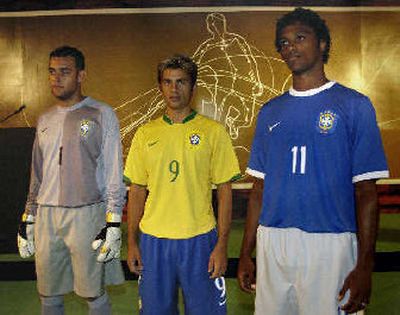Soccer fashions go on display

NEW YORK – World Cup fans are accustomed to the yellow of Brazil, the blues of France and Italy and the stripes of Argentina and Paraguay. They should get ready for the elephants of Ivory Coast, the eagles of Tunisia and the black stars of Ghana.
The uniforms of this year’s World Cup teams are as varied as the 32 countries they represent, almost all carrying a distinct look. It’s a change from recent years, when major manufacturers devised patterns and merely changed the colors to adapt to the country.
Bigger federation badges, pinstripes and gold piping are some of the changes. Adidas, Nike and Puma are trying to meld tradition, national honor and their own brand identity into shirts, shorts and socks for the fields of Germany.
“It’s our Milan runway, it really is,” said Peter Hudson, Nike’s creative director of global soccer.
With soccer’s premier international events generally on a two-year calendar, many national teams update their uniform every 24-48 months.
But with 48 pages of rules from FIFA regulating what can and can’t be worn, manufacturers have limited discretion, which is sometimes further restricted by federations, their teams and players who actually have to don the garb.
Some federations allow almost no deviation from their traditional uniforms, such as Brazil’s yellow or Argentina’s blue-and-white vertical stripes. The biggest change for Brazil this year is a green standup collar.
African teams, however, have been the testing grounds for some of the more innovative designs. Four years ago, Puma outfitted Cameroon in a sleeveless shirt worn during the African Cup – until quashed by FIFA, which demanded sleeves. Puma had to quickly add a black mesh to meet the requirement.
Two years ago, Puma again introduced a one-piece uniform, which soccer officials also nixed.
“We push our interests,” Puma international team sport business unit manager Filip Trulsson said. “It’s not a matter of Puma going up against FIFA on an annual basis, but we want to stretch the boundaries.”
Puma will outfit 12 of the 32 teams in Germany, including all five African teams. Eight more will be wearing Nike uniforms and six others have Adidas. Lotto and Umbro will outfit two teams apiece, while smaller manufacturers Marathon (Ecuador) and Joma (Costa Rica) have one each.
Puma this year will have tonal prints sewn into the fabric of nine teams, a darker or lighter shade of the primary color in patterns specific to the countries: an elephant (Ivory Coast), a hawk (Togo), stars (Ghana), an eagle (Tunisia), a lion (Czech Republic), the Swiss flag (Switzerland) or a palm tree with crossed swords (Saudi Arabia).
Recently, most major manufacturers developed a stock pattern for jerseys, blending in the colors of the countries to highlight their brand.